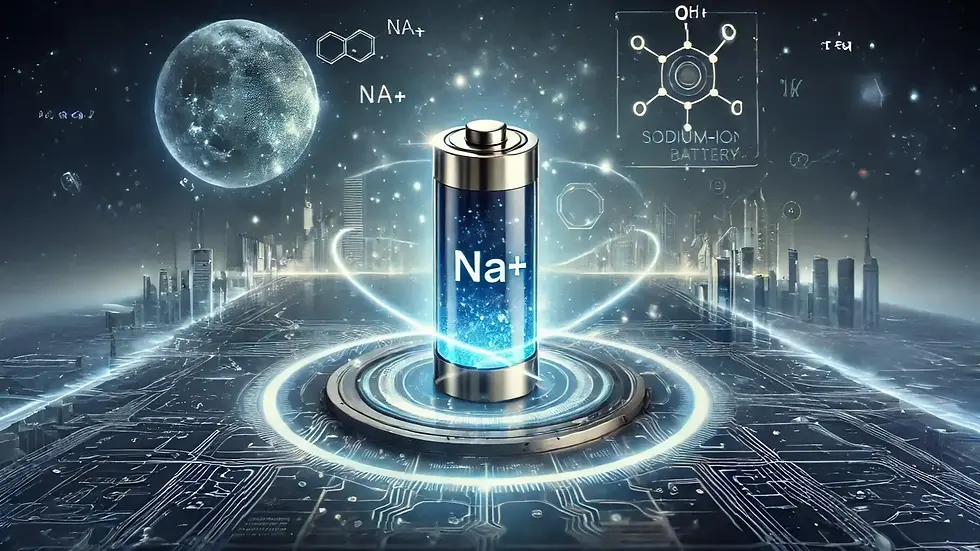The Future of Energy Storage | Sodium-Ion Batteries
- Kalyan Bhattacharjee
- Mar 19
- 3 min read
Updated: Mar 22

The Rise of Sodium-Ion Batteries: A Lithium Alternative?
Overview
As the demand for energy storage solutions continues to grow, researchers and industries are exploring alternatives to traditional lithium-ion batteries. One promising contender in the field of rechargeable batteries is the sodium-ion battery (Na-ion battery). With abundant raw materials, cost-effectiveness, and environmental benefits, sodium-ion batteries are gaining attention as a viable alternative to lithium-based solutions.
What is a Sodium-Ion Battery?
A sodium-ion battery operates similarly to a lithium-ion battery but uses sodium ions (Na⁺) instead of lithium ions (Li⁺) to store and transfer energy. These batteries consist of three main components:
Cathode: Typically made from sodium-based compounds like sodium manganese oxide (NaMnO₂) or sodium iron phosphate (NaFePO₄).
Anode: Materials like hard carbon, which efficiently store sodium ions.
Electrolyte: A sodium-based salt dissolved in an organic or aqueous solvent, facilitating ion movement.
When the battery is charged, sodium ions move from the cathode to the anode through the electrolyte, storing energy. During discharge, they return to the cathode, releasing energy to power electronic devices.
How Does a Sodium-Ion Battery Work?
Sodium-ion batteries function similarly to lithium-ion batteries but use sodium ions (Na⁺) as charge carriers instead of lithium ions. During charging, sodium ions move from the cathode (positive electrode) to the anode (negative electrode) through an electrolyte, storing energy.
When discharging, the ions travel back to the cathode, releasing stored energy to power devices. These batteries use abundant sodium resources, making them a promising alternative for large-scale energy storage, especially in renewable energy applications. However, ongoing advancements are needed to improve their energy density and cycle life.
Advantages of Sodium-Ion Batteries
Abundant and Low-Cost Materials
Unlike lithium, which is rare and expensive to mine, sodium is widely available in seawater and minerals, making sodium-ion batteries significantly cheaper to produce.
Eco-Friendly and Sustainable
Lithium mining has raised environmental concerns due to water usage and pollution. Sodium-ion batteries have a lower environmental impact, making them a greener energy storage option.
Safer Alternative to Lithium-Ion Batteries
Sodium-ion batteries are less prone to overheating and thermal runaway, reducing the risk of explosions or fires. This makes them safer for large-scale energy storage applications.
Improved Performance in Low Temperatures
Sodium-ion batteries perform better in colder environments than lithium-ion batteries, making them suitable for regions with extreme climates.
Want to know the main difference between Sodium ION and Lithium ION Batteries
Click here:
Challenges of Sodium-Ion Batteries
While sodium-ion technology has significant potential, it also faces some challenges:
Lower Energy Density: Sodium-ion batteries currently have a lower energy density than lithium-ion batteries, meaning they store less energy per unit weight.
Larger Sodium Ions: Sodium ions are larger than lithium ions, making it harder to achieve compact and high-capacity designs.
Limited Commercial Availability: While research is advancing, large-scale commercial production of sodium-ion batteries is still in its early stages.
Applications of Sodium-Ion Batteries
Despite these challenges, sodium-ion batteries have promising applications in various sectors:
Grid Energy Storage: Ideal for storing renewable energy (solar and wind) in power grids due to their affordability and longevity.
Electric Vehicles (EVs): Companies are exploring sodium-ion batteries as a cost-effective solution for EVs and hybrid vehicles.
Consumer Electronics: Although not yet widespread, sodium-ion technology could power smartphones, laptops, and other devices in the future.
The Future of Sodium-Ion Batteries
Major companies, including CATL, Faradion, and Natron Energy, are investing in sodium-ion battery research and production. As advancements continue, we can expect improvements in energy density, charge cycles, and efficiency, making sodium-ion batteries a key player in the future of energy storage.

Conclusion
Sodium-ion batteries represent a sustainable and cost-effective alternative to traditional lithium-ion batteries. While there are still hurdles to overcome, ongoing research and innovation are pushing this technology toward commercial viability. As the world transitions to cleaner energy solutions, sodium-ion batteries could revolutionize how we store and utilize power.
Would you consider switching to sodium-ion batteries for your energy needs? Share your thoughts in the comments below!
sodium ion battery vs lithium ion battery, sodium battery companies, sodium batteries, battery sodium, how does sodium ion battery work, who makes sodium ion batteries, are sodium ion batteries better than lithium, batterie sodium-ion, sodium ion batteries, a cost and resource analysis of sodium-ion batteries, are sodium ion batteries better than lithium, how does sodium ion battery work, fintech shield

Comentarios